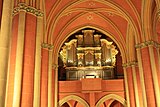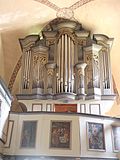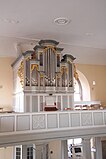Johann Andreas Heinemann
Johann Andreas Heinemann (born February 2, 1717 in Großlöbichau ; buried February 28, 1798 in Gießen ) was a German organ builder who worked in Hesse in the 18th century .
Life
Heinemann came from Thuringia and was the son of Hans Heinemann and Anna Catharina geb. Heinermann. He probably received his first training from his relatives in Großlöbichau ; The activity and whereabouts after 1741 are unclear. In 1747 he is proven as a journeyman of the Thuringian organ builders Johann Casper Beck and Johann Michael Wagner . From 1747 to 1750 they created the organ of the Laubach town church , in whose construction Heinemann played a key role. On May 9, 1748, Heinemann married Anna Christine Philippine Schmidt (June 13, 1722 - March 30, 1763) in Laubach and had four children with her, who were born between 1749 and 1759: Catharina Christiane (born June 14, 1749) , Anton Friedrich Gottlieb (* March 8, 1751 - November 17, 1804 in Rotterdam ), Johann Georg (* November 18, 1755; † 1787 in Gießen) and Catharina Eleonore (* May 23, 1759). There he went freelance as an organ builder. After obtaining permission from Count Christian August , he moved his workshop to Gießen in 1765 and obtained the privilege of organ maker in Hessen-Darmstadt on January 24, 1766. On the other hand, the famous master in Hessen-Kassel received only a few orders, as the local organ builders protested vigorously against the "foreigner". Heinemann was buried in Giessen on February 28, 1798. His son-in-law Johann Peter Rühl, who married Catharina Christiana Heinemann on July 30, 1789, came from Gießen and took over the workshop with the marriage. Rühl's daughter married Johann Georg Bürgy in 1809 , who continued the Gießen workshop after Rühl's death until his death in 1841.
The son Antonius Friedrich Gottlieb Heyneman also became an organ builder and moved to the Netherlands. A number of conversions, repairs and maintenance contracts are documented here, but also some new buildings. He earned a reputation as one of the "finest domestic artists and craftsmen" and also created cabinet organs.
plant
Heinemann is considered to be the most important organ builder in Upper Hesse in the second half of the 18th century. His works are largely shaped in the Rococo style. He uses a very low wind pressure , which is less than 60 mm water column in the preserved works . Compared to contemporary organ builders, the manual works have an expanded range of 53 notes (C – e 3 ), while the pedal range of two full octaves (C – c 1 ) corresponds to the Central German standard. Heinemann's works are characterized by a high level of craftsmanship in wood and metal processing. The central German work structure with the main work, upper work and pedal positioned behind it resembles the two-manual works by Gottfried Silbermann .
Most of his organs, however, are single-manual and have a five-axis prospect for instruments with up to 15 stops (Dauernheim). This has a raised central tower, medium-sized outer towers and low flat fields between the towers or in a few cases flat round fields. At Heinemann, the flat fields are single-storey and only two-storey or in two different boxes on top of each other from 14 registers. Only in Kleinseelheim and Trais-Horloff are the low fields pointed. As a rule, the single-storey flat fields close at the top with a rather high veil. Heinemann preferred harp fields until 1773, after which they are no longer used except for Freienseen. The tower roofs are richly profiled and protrude upwards in a trapezoidal shape. There are quite high boards between the lower cornice and the pipe fields. The wind chests are installed higher than the cornice so that the valves are more easily accessible from the front. The blindness through intent can also be found in the organ builder family Zinck , Johann Friedrich Syer and Johann Conrad Bürgy . Only in Kleinseelheim and Nidda do the outer towers set deeper. For the three towers, the sequence is pointed - round - pointed (Viermünden / Gellershausen, Ortenberg, Kirchgöns, Dauernheim, Freienseen) or round - pointed - round (Kleinseelheim, Trais-Horloff, Kirchberg, Nidda).
The organs in Nieder-Gemünden (1760) and Breidenbach (1769) are largely original. For the collegiate church in Wetter (1763–1766) he created a two-manual work. The anonymous works in Rodheim (1776) and Freienseen (1797) possibly go back to the Heinemann / Rühl workshop.
List of works
So far, more than a dozen one or two-manual new organs by Heinemann have been proven. His son-in-law was involved in the last work.
Italics indicate that the organ has not been preserved or only the historical case has been preserved. In the fifth column, the Roman number indicates the number of manuals , a capital "P" indicates an independent pedal , a lower-case "p" indicates a pedal that is only attached. The Arabic number indicates the number of sounding registers . The last column provides information on the state of preservation or special features.
| year | place | church | image | Manuals | register | Remarks |
|---|---|---|---|---|---|---|
| 1747-1751 | Laubach | Ev. City Church |

|
II / P | 21st | Assistance in building the new organ; partially preserved (today III / P / 28) → organ |
| 1751-1753 | Kirchhain | St. Michael |

|
I / P | 16 | Housing received |
| 1753 | Ober-Gleen | Ev. church | I / P | 11 | Partly preserved | |
| 1758 | Kleinseelheim | Ev. church | I / P | 10 | 1846 reconstruction by Peter Dickel ; Housing and 7 registers preserved | |
| 1757-1760 | Nieder-Gemünden | Ev. church | I / P | 11 | Largely preserved | |
| 1763-1766 | Weather | Stift Wetter , collegiate church |

|
II / P | 22nd | Two thirds of the registers preserved; Console and action replaced later; 1997–1999 restoration / reconstruction and addition of three pedal stops on a separate drawer by Förster & Nicolaus Orgelbau (1997–1999); today II / P / 25 |
| 1764-1766 | Wetzlar | Hospital Church |

|
I / P | 15th | Replaced by a new Walcker organ in 1931; Housing received |
| 1767 | Josbach | Ev.-luth. church | I. | 8th | 1967 remodeling by Werner Bosch ; Case and 4 registers from Heinemann preserved | |
| 1767-1769 | Breidenbach | Ev. church | I / P | 14th | Largely preserved, restored by Hillebrand in 1971/1972 | |
| 1769-1771 | Goat grove | City Church | I / P | 14th | Prospectus like Breidenbach; 1847–1849 extension conversion by August Röth (II / P / 20), 1963–1965 conversion by Euler; In the main work 3 registers completely and 1 partially preserved | |
| 1772 | Goat-Nidda | Ev. church | I / P | 9 | Not received | |
| 1773 | Viermünden | Ev. church | I. | 5 | Housing possibly preserved in Gellershausen | |
| 1776 | Laufdorf | Ev. church |

|
I / P | Housing received | |
| 1776 | Trais-Horloff | Ev. church |

|
I / P | 13 | Attribution; various conversions |
| 1777/1778 | Kirchberg | Ev. church | I / P | 11 | Largely preserved | |
| 1780 | to water | Castle Church | II / P | 22nd | Attribution; 1821 transfer to the newly built town church ; not received | |
| 1781 | Nidda | City Church of the Holy Spirit |

|
I / P | 14th | Replaced in 1935; 2018 New building by Hermann Eule Orgelbau Bautzen in the Hessian-Central German Baroque style behind the preserved prospectus |
| 1784 | Ortenberg | Marienkirche |

|
I / P | Replaced in 1939; Housing received | |
| 1792 | Kirch-Göns | Ev. church |

|
I / p | 8th | executed by Johann Peter Rühl; 1862 reconstruction by Adam Karl Bernhard ; almost completely preserved |
| 1794 | Permanent home | Trinity Church | I / P | 15th | Together with Rühl; most of the registers preserved | |
| 1797 | Open lakes | Ev. church | I / P | 14th | Together with Rühl; largely preserved |
Recordings / sound carriers
- Organ music on the Heinemann organ in Wetter . AV Studio Helmut Buchholz, AV-9-00-1000 (Klaus-Jürgen Höfer and Christian Zierenberg with works by JS Bach, D. Buxtehude, JL Krebs, CH Rinck)
- Music from Saxon castle churches: works for baroque oboe and organ around and after Bach . Cantate, C 58038, 2008 (Concerto Royal Cologne with W. Kronenberg on the organ in Wetter: Works by JS Bach, GF Eberhardt, GA Homilius, JL Krebs, CG Tag)
literature
- Hans Martin Balz , Reinhardt Menger: Old organs in Hessen and Nassau . 2nd Edition. Merseburger, Kassel 1997, ISBN 3-87537-169-0 (publication by the Society of Organ Friends 72).
- Franz Bösken : Sources and research on the organ history of the Middle Rhine (= contributions to the Middle Rhine music history . Volume 7.1 ). tape 2 : The area of the former administrative district of Wiesbaden. Part 1: A-K . Schott, Mainz 1975, ISBN 3-7957-1307-2 .
- Franz Bösken: Sources and research on the organ history of the Middle Rhine (= contributions to the Middle Rhine music history . Volume 7.2 ). tape 2 : The area of the former administrative district of Wiesbaden. Part 2: L-Z . Schott, Mainz 1975, ISBN 3-7957-1370-6 .
- Franz Bösken, Hermann Fischer : Sources and research on the organ history of the Middle Rhine (= contributions to the Middle Rhine music history . Volume 29.1 ). tape 3 : Former province of Upper Hesse. Part 1: A-L . Schott, Mainz 1988, ISBN 3-7957-1330-7 .
- Franz Bösken, Hermann Fischer: Sources and research on the organ history of the Middle Rhine (= contributions to the Middle Rhine music history . Volume 29.2 ). tape 3 : Former province of Upper Hesse. Part 2: M-Z . Schott, Mainz 1988, ISBN 3-7957-1331-5 .
- Hermann Fischer, Theodor Wohnhaas : Lexicon of southern German organ builders . Florian Noetzel Verlag, Wilhelmshaven 1994, ISBN 3-7959-0598-2 .
- Dieter Großmann: Johann Andreas Heinemann . In: Hessian homeland . tape 9, 1959/60 , no. 38 , p. 16-21 .
- Dieter Großmann: organs and organ builders in Hessen . 2nd Edition. Trautvetter & Fischer, Marburg 1998, ISBN 3-87822-109-6 (contributions to Hessian history 12).
- Eckhard Trinkaus: Johann Andreas Heinemann . In: Ars Organi . tape 48 , 2000, pp. 28-34 .
- Eckhard Trinkaus: organs and organ builder in the former district of Ziegenhain (Hesse) . Elwert, Marburg 1981, ISBN 3-7708-0713-8 (publications of the Historical Commission for Hesse 43).
See also
Individual evidence
- ^ A b Eckhard Trinkaus: Johann Andreas Heinemann . In: Ars Organi . tape 48 , 2000, pp. 30 .
- ^ Bösken, Fischer: Sources and research on the organ history of the Middle Rhine. Volume 3, Part 1: A – L. 1988, pp. 15, 520.
- ↑ Eckhard Trinkaus: Organs and Organ Builders in the former Ziegenhain District (Hesse) (= publications of the Historical Commission for Hesse . No. 43 ). Elwert, Marburg 1981, ISBN 3-7708-0713-8 , pp. 253 .
- ^ Eckhard Trinkaus: Johann Andreas Heinemann . In: Ars Organi . tape 48 , 2000, pp. 31 .
- ^ Eckhard Trinkaus: Johann Andreas Heinemann . In: Ars Organi . tape 48 , 2000, pp. 34 .
- ^ Fischer, Wohnhaas: Lexicon of south German organ builders. 1994, p. 148.
- ^ Klaus-Jürgen Höfer: Experiences with the restored Heinemann organ in the collegiate church in Wetter . In: Quintet . No. 10, 2006, pp. 3–5 ( online ), accessed on April 17, 2018 (PDF; 1.93 MB).
- ↑ Krystian Skoczowski : The organ builder family Zinck. A contribution to the research of organ building in the Wetterau and the Kinzig valley in the 18th century. Haag + Herchen, Hanau 2018, ISBN 978-3-89846-824-4 , pp. 249-251.
- ^ Bösken: Sources and research on the organ history of the Middle Rhine. Volume 2, Part 1: A – K. 1975, p. 96 f.
- ^ Bösken, Fischer: Sources and research on the organ history of the Middle Rhine. Volume 3, Part 1: A – L. 1988, p. 307 f .; Part 2: M – Z. 1988, p. 922.
- ↑ See the list of works by Eckhard Trinkaus: Johann Andreas Heinemann . In: Ars Organi . tape 48 , 2000, pp. 31 f .
- ↑ Dieter Schneider: The 200th Heyne-Orgel to Breidenbach. In: Hinterland history sheets. Vol. 48, No. 2, 1969, p. 12.
- ^ Bösken, Fischer: Sources and research on the organ history of the Middle Rhine. Volume 3, Part 1: A – L. 1988, p. 380 f.
| personal data | |
|---|---|
| SURNAME | Heinemann, Johann Andreas |
| ALTERNATIVE NAMES | Heynemann, Johann Andreas |
| BRIEF DESCRIPTION | Hessian organ builder |
| DATE OF BIRTH | February 2, 1717 |
| PLACE OF BIRTH | Großlöbichau |
| DATE OF DEATH | buried February 28, 1798 |
| Place of death | to water |






